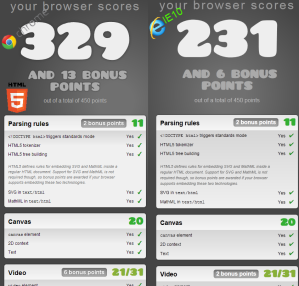Browser Wars – Rich Internet Applications and Consumers Benefit – Internet Explorer 10.0 Preview 2
Level: Geek 2 {all readers with some techie facts}
One of the most profound social reactions in the world is the concept of “competition.” Not only does it effect people, markets, and products, but also helps the world to evolve, especially in the world of technology and software.
Where there is competition, there is evolution. The need to supersede the competitor!
In the world of ‘The Internet’, and what technologists are calling Web 2.5, Web Browsers (The thing you use to surf the web) have been fighting it out to be the ‘next’ choice of consumers to run the next-generation web-based applications. Whether it is on their desktop, laptop, tablet, or phone, browsers are quickly becoming the target for development of new cross-device, cross platform, applications that will make it easier for competitors to follow the old “Build it once” paradigm.
Microsoft released Internet Explorer 9.0 in March 2011 to competitively place themselves in the market as a next-gen web browser. Some of the major features to IE9.0 were the fact that the rendering of the html page (producing content on the page) was hardware accelerated and the Javascript engine was as well. (For geeks: IE9 compiles JavaScipt down to native code and handled by the hardware) IE9 also added quite a bit of support for the new HTML5 standards. Microsoft was quite judicious and conservative with what components of the HTML5 standard they added support for in IE9. I suspect that this is because there is still quite a bit of battling for portions of the standard which are not yet complete. Some of the components of the standard are still in planning phases.
Internet Explorer 10.0 Preview 2.0 has become the next evolution for Microsoft’s browser. Not only do they support quite a bit more of the HTML5 standards, they are also offering increased performance on the existing support.
One standard I was hoping they would add was around “Workers”. Web Workers are a standard that are compared to the desktop application concept of threads. Web Workers was added to the IE10 Preview 2. (IE still doesn’t support ‘shared workers’ like Chrome 13 Beta)
Another huge jump was in the User Interaction portion of the HTML5 standard support. Drag and drop Attributes and Event support was added which equals out the support to Google Chrome’s 13 beta. This will help with making it easier for touch devices to move things around the screen. I am looking forward to playing with this feature on multiple browsers.
In the subject of parsing, HTML 5 tokenizers, tree building, MathML in text/html had support added. In html Elements, IE still does’nt support the global “hidden” attribute. I suspect it has to do with how the rendering engine handles hidden objects.
In web Forms there has been a substantial jump in compatibility: Several Input Types added like search, tel, url, email, checkbox, image (even over Chrome 13 beta), datalist (over Chrome 13 beta), Field Validation, Association of controls and forms, CSS Selectors.
There was actually a downgrade from Internet Explorer 9.0 (IE9) to IE10.0 Preview 2. It lost the Web Applications capability of using custom search providers. This could be a mistake! Hopefully the team will catch this before the major release.
In the same section, Web Apps, still have no support for Application Cache, scheme handlers or content handlers, unlike Chrome’s beta.
Security was added to Iframe around sandboxing iframes bringing it neck-in-neck with the Chrome beta.
File interaction was added around FileReader API’s. My guess is FileWriter APIs are close behind it in the final release of 10.0. Chrome 13 beta doesn’t have FileWriter support yet as well. It
seems theW3C HTML5 standard for this is not yet locked down.
With talk about Windows 8, Browser Applications on IOS and OSX, and Android adding more support for HTML5 standards on the OS, Internet Explorer 10.0 is shaping up to be a true competitor in the market.
The idea behind competitor browsers adding more support for HTML5 and performance increases should not be about which company is better, it is all about making it easier for consumers to build applications that work everywhere across all platforms. (Offline and Online) Competition is driving this mandate and the evolution of these products, but the consumers and developers are the ones that benefit.
Competition will continue to be the driving force behind the need to evolve, and the actual evolution will help benefit the world with how we are socially connected and productive.
Until next time…



